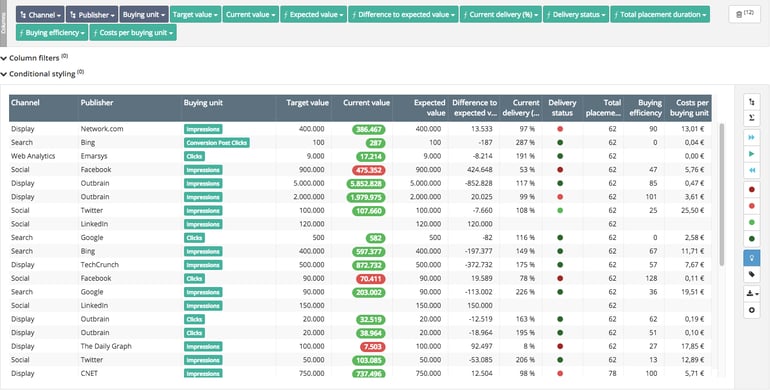It has never been easier to buy, work with and analyse your paid marketing activities. Self-service tools like the Facebook Ad Manager or LinkedIn Campaign Manager are by far the most user-friendly media buying tools on the global market. No wonder these tools help bring in the big bucks for these companies. But these social media platforms ordinarily only cover a small part of your campaign. Large corporations, big spending brands and many other advertisers face a pressing need to maintain and promote a large media spectrum. In this case, media buying agencies often adopt a holistic approach to developing their advertising campaigns.
Knowing the agency pains inside out
A big part of our team has been working in the agency business for years and we know the industry pains by heart. One of our main tasks was to lead the process of media strategy, planning and buying. The execution of this part has always been a well-known process - but the struggle comes with the quickly increasing number of platforms, ad-tech solutions and measurement tools. Therefore, nowadays a media plan needs to be so much more than just a short excel sheet outlining your target group and planned costs. They are actually living, breathing documents that follow the cycle of each and every campaign.
With our media planning tool, we are dealing with this issue full-frontal. Modern agencies and consulting businesses are following the same and well-established pattern: briefing → planning → approval → buying → monitoring → reporting. And instead of dealing with the stages individually, we've created a safe space for these data to live and breathe.
Briefing: An agency client provides detailed insights into the target group demographics, budget, time period and overall goals of the campaign. Depending on the type of collaboration, there will be a process to define the creatives, format, placements and preferred networks.
Planning: This process considers everything outlined in the briefing stage and how the advertising campaign will be executed. The media planners work closely with market research teams and publishers to effectively disseminate marketing messages across different target groups within the most appropriate contexts. This requires ads to be displayed to the well-targeted groups at the right time in the right environment. Resources are divided across many positions to find a cost-effective way of reaching the target audience across devices, pages and within different environments.
Approval: Experience would suggest that this stage often requires many feedback loops and iterations before the marketing plan can be signed off by the client's management. In reality, that often includes working with an array of different spreadsheets - requiring an acute awareness of the finer details under consideration. But when you've successfully negotiated your path to a finalized plan, you can begin work on the campaign. Yay.
Buying: Media buying essentially involves reserving paid media slots and advertising spaces for displaying your clients’ ads. Regardless of whether this buying process is for online or offline media, the process typically remains the same for each media channel. You'll be required to work closely with the publishers and negotiate the costs of each ad position based on performance-oriented metrics, such as reach or costs for specific actions e.g. cost per click or cost for reaching a number of people. Media agencies aim to find the best distribution channels, negotiate a more favorable price before taking care of measurement, ad serving, trafficking and reporting. Of course, in a digital first world, there are lots of ways to buy your media space programmatically, which means you don’t have to go through a vendor or a sales representative. Instead, you let the demand and supply sides talk automatically to each other - increasing the efficiency of the whole process. But again, in a larger campaign that involves TV, out-of-home, print media as well as different online placements, there is still a need to construct a well-crafted media plan that outlines and compares run times, costs, placements, frequency, target groups and buying models.
Monitoring: Documenting the working procedures and providing insights into a campaign's performance is an essential part of every marketers daily business. For agencies, this is especially true as there is not only a report generated at the end of a given campaign, but clients tend to ask for daily updates on the costs, delivery, visibility and efficiency of ongoing campaigns. Again, this process is mostly flawed as campaign managers have to gather the data by logging into multiple platforms and transform it into a consistent structure before they can copy, paste and arrange it into the desired format. In short, this is tedious manual work that needs to be replaced by an automated process. Increasing the efficiency of this entire process is a big part of Adverity’s core business.
Reporting: So, after monitoring and optimizing each and every campaign, most will have an expiry date. Reporting typically consists of documenting how the campaign was delivered, how each placement performed as well as provided a written interpretation of the data. Did the agency manage to meet the goals of the campaign? How efficient was the buying process? Is there still budget left? A big part of this exercise is to convince all stakeholders of the effectiveness of the campaigns. After all, this has to contribute to the bottom line of each business. The art of presenting findings to different target groups is something you have to be very aware of, and good at. By having an astute awareness of the different needs of each stakeholder, proficient marketers will know that CEOs will have different interests and viewpoints to the average marketing executive. This is why it is advisable that marketers deliver tailor made dashboards to leverage the right messages across all teams.
We've improved the entire process of working with media plans
 NB Screenshot is for illustrative purposes only and was generated using test data.
NB Screenshot is for illustrative purposes only and was generated using test data.
We provide agencies with the possibility to work with media plans in a completely new way, whereby users can easily upload their approved media plans to our platform and add them to dashboards that allow for easy sharing and manipulation. While we cannot free you from planning and executing the advertising stages, we're able to take care of pretty much everything else.
- Instead of sharing a new file-based spreadsheet after each feedback loop, you'll be able to share the link to a media plan, where all stakeholders will see the updated plan in real time. This saves a lot of time and confusion: there are no more duplicate files, no more miscommunication between the client and the agency due to different versions of your excel file.
- A complex but very important part of a well crafted, modern media plan is the use of standardized marketing metrics across all your media channels. Why? You are constantly measuring the performance of your ads and comparing different KPIs - and we offer a custom framework for your metrics, and therefore a systematic approach for applying a consistent structure across all campaigns, regions, brands, placements, currencies, time format and column naming. Think of it as a huge and highly complex mapping table, which aligns all your performance metrics so you can compare apples alongside other unified apples.
- This media plan feature is already highly resourceful when dealing with one campaign. But of course, it can be used for all of your clients. The best thing is: you can see all ongoing campaigns from all your clients simultaneously. You can sort by placement, vendor, date or any other dimension to get your desired viewpoint from an agency's activity at any given time. This is especially powerful when you want to see which campaigns are currently on track to deliver their targets and those that are lagging behind. Ad operations managers love this feature as they are able to get a quick update from each publisher on their current performance against their pre-defined goals.
- Another huge advantage is the ability to quickly optimize all ongoing campaigns on the fly. Is the Facebook campaign struggling to deliver the clicks that you had hoped for? Perhaps an adjustment to the targeting will garner more success? In cases where campaigns are due to come to an end but not all the budget has been spent, budgets can be reallocated to boost metrics that may have fallen short of meeting their targets. Being able to react quickly to unexpected deliveries and performances is a crucial feature that will prove vital in providing you with a competitive edge. Fast and easy visibility of your existing metrics and performance indicators is one thing, but being able to readily define new, custom KPIs for your business is critical when you want to bypass a lot of the dirty work.
- “Expected Delivery” is one of our clients' favorite formula as it provides users with the calculated end of a campaign based on the delivery progress across all running campaigns. Moreover, “Buying Efficiency” provides a useful ratio for the price you planned to pay versus the price you are actually paying.
- Business agility as a result of transparency. We're pleased to say that we've made this campaign optimization process far more efficient. Anyone who has been granted the necessary user rights is able to access the data and work with it in the Campaign Monitoring tool. Ad delivery updates, decision making and overall marketing performance has been improved significantly for all of our clients.
So, how will media plans be dealt with in the future? As with all other data, it becomes increasingly powerful when presented alongside each other and provides a holistic view of your marketing performance. Only if you can blend the information from your advertising campaigns with first-party data from your website, CRM and sales, as well as any other e-commerce or measurement and analytics source, you'll be on the right path towards a wonderful data-driven journey.










.png?width=725&height=480&name=media-plans%20(1).png)

